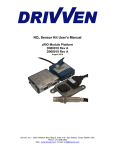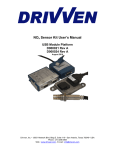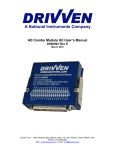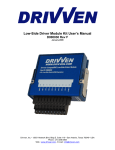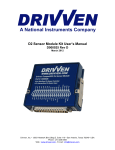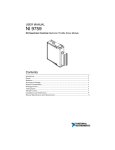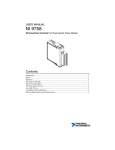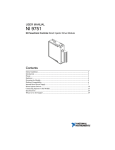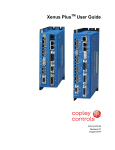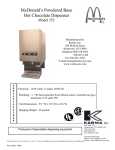Download NOx Sensor Module Kit User`s Manual
Transcript
NOx Sensor Module Kit User’s Manual D000018 Rev A D000019 Rev A January 2009 Drivven, Inc. • 12001 Network Blvd, Bldg E, Suite 110 • San Antonio, Texas 78249 • USA Phone : 210.248.9308 Web : www.drivven.com , E-mail : [email protected] Drivven, Inc. NOx Sensor Module Kit Contents Introduction ......................................................................................................................... 3 System Diagram .................................................................................................................. 3 Hardware ............................................................................................................................. 4 Powering the Hardware....................................................................................................... 4 NOx Sensor Module Specifications .................................................................................... 5 Platform Compatibility ....................................................................................................... 8 Software .............................................................................................................................. 9 Creating a LabVIEW Project ............................................................................................ 10 Exploring the Example Project ......................................................................................... 12 Sub VI Documentation ..................................................................................................... 17 © Drivven, Inc. 2009 • NOx Sensor Module Kit User’s Manual • D000018, D000019 • Rev A 2 Drivven, Inc. NOx Sensor Module Kit Introduction The Drivven cRIO NOx Sensor Module Kit provides an interface for one or two NOx and O2 exhaust gas sensors. Features: ¾ ¾ ¾ ¾ ¾ ¾ ¾ ¾ ¾ 1-Ch. or 2 Ch. system Triple signal output: o NOx concentration (ppm) o O2 concentration (%) Sensor controller supply voltage of 12V to 32V Reverse battery protection on sensor controller module Integrated with LabVIEW FPGA and LabVIEW RT to provide real-time data LabVIEW FPGA and RT VIs included for quick integration with application Wide range of applications: o Gasoline / Diesel o Passenger car / Truck Helps to achieve emissions requirements Includes sensor controller module connector kit System Diagram Drivven NOx Sensor Module Kit NI 9853 for CompactRIO CAN 1 Sensor Controller Module CAN 2 Additional Optional Sensor LabVIEW FPGA Interface to NI 9853 LabVIEW RT Interface to LabVIEW FPGA Driv v en Integration Softw are Support Prov ides NOx and O2 Data to User Application NOx and O2 Sensor © Drivven, Inc. 2009 • NOx Sensor Module Kit User’s Manual • D000018, D000019 • Rev A 3 Drivven, Inc. NOx Sensor Module Kit Hardware This kit provides the following hardware: 1 Continental Smart NOx Sensor with integrated sensor controller module 1 Sensor bung 1 Connector kit for NOx sensor controller module 1 National Instruments NI-9853 CompactRIO CAN module The end user must provide wiring for connecting the sensor controller module to a power supply and the NI 9853 CAN module. A connector kit is provided for the sensor controller interface. The end user must provide a DB-9 connector kit for connecting to the NI 9853 CAN module. Any DB9 connector system may be used. Drivven recommends the following DB-9 connector parts and tools available from several electronics parts distributors (Allied, Mouser, Digikey, etc.). Table 1. Connector parts list Description AMP HDP-20 Series 109 9P Receptacle Housing AMP HDP-20 Series 109 Crimp Socket Contact Norcomp D-Sub Connector Hood, 9P 45 Degree AMP D-Sub Insert/Extract Tool Paladin D-Sub 4-Indent Crimp Tool 26-20 AWG Mfr.’s Part # 1757820-1 205090-1 971-009-020R121 91067-2 1440 CAN network wiring guidelines must be followed. Please refer to the operating instructions provided with the NI 9853 CAN module. A terminating resistor of approximately 120 ohms must be connected between CAN High and CAN Low pins. Powering the Hardware The NOx Sensor Controller Module requires power from a range of 12V to 32V with a continuous current of 0.6A and a peak current of 12A. The maximum power requirement is 20W. For power requirements of the NI 9853 CompactRIO CAN module, please refer to the National Instruments NI 9853 Operating Instructions. © Drivven, Inc. 2009 • NOx Sensor Module Kit User’s Manual • D000018, D000019 • Rev A 4 Drivven, Inc. NOx Sensor Module Kit NOx Sensor Module Specifications Table 1. NOx Sensor Performance Specifications Output Measurement Accuracy Type Range NOx O2 0 – 3000 ppm -12 – 21 [%] @ 0 ppm: ±10 ppm @ 100 – 1500 ppm: ±10% @ 1500 – 3000 ppm: undefined @ λ=0.90: ±1.4% (fresh) @ 0% (λ=1.00): ±0.13% (fresh) @ 0% (λ=1.00): ±0.25% (aged) @13% (λ=2.65): ±0.32% (fresh) Response Time (33-66%) Data Update Rate 1300 ms (fresh) 1650 ms (aged) 1000 ms (fresh) 1300 ms (aged) 50 ms interval @ 250 kBaud NOx Sensor Light-off times (Conditions: Air T = 25 ±5°C, BattV = 28V, Heater turned ON) NOx < 100 sec O2 < 80 sec NOx Sensor Preheating Function If power supply is on, the sensor is in preheating mode until the Heater Boolean is set to TRUE. If the Heater Boolean is set to FALSE, the sensor returns to preheating mode. The preheating mode protects the sensor from mechanical cracks caused by water splash. © Drivven, Inc. 2009 • NOx Sensor Module Kit User’s Manual • D000018, D000019 • Rev A 5 Drivven, Inc. NOx Sensor Module Kit NOx Sensor Operating Temperature Ranges Minimum sensor module controller temperature -40°C Maximum sensor module controller temperature 105°C Sensor module controller temperature range of 85°C to 100°C allowed for up to 10 minutes Minimum storage temperature Maximum storage temperature Maximum storage time -40°C 120°C 2 years Maximum exhaust gas temperature Exhaust gas temperature of 950°C allowed up to 100 hours 800°C Maximum sensor hexagon screw temperature 620°C Sensor hexagon screw temperature of 650°C allowed for up to 100 hours Maximum sensor grommet temperature 200°C Sensor grommet temperature of 230°C allowed for up to 100 hours Minimum preheating sensor temperature Maximum preheating sensor temperature 80°C 120°C Lifespan approved by life cycle pattern 2000 hours or 120K miles NOx Sensor Electrical Characteristics NOx Sensor Supply Voltage Minimum supply voltage Maximum supply voltage If supply voltage > 32 V, sensor is not operated 12 V 32 V NOx Sensor Supply Current Average supply current Peak supply current at switch on Inrush current 0.6 A 12 A 20 A Supply Power Maximum supply power 20 W NOx Sensor Misc. Thread Torque 50 Nm Lubrication Anti-Seize Compound © Drivven, Inc. 2009 • NOx Sensor Module Kit User’s Manual • D000018, D000019 • Rev A 6 Drivven, Inc. NOx Sensor Module Kit Installation Position: Tilt Angle in Gas Flow Direction: NOx Sensor Controller Module Connector Type of connector Number of pins Connector pin assignment Hirschmann MLK 872-860-501 5 Pin 1: Battery Pin 2: Ground Pin 3: CAN Low Pin 4: CAN High Pin 5: Not Used © Drivven, Inc. 2009 • NOx Sensor Module Kit User’s Manual • D000018, D000019 • Rev A 7 Drivven, Inc. NOx Sensor Module Kit Platform Compatibility CompactRIO modules from National Instruments are compatible within two different platforms from National Instruments. One platform is CompactRIO, consisting of a CompactRIO controller and CompactRIO chassis as shown in Figure 1a below. Figure 1a. CompactRIO platform compatible with Drivven/NI CompactRIO modules. The other platform is National Instruments PXI which consists of any National Instruments PXI chassis along with a PXI RT controller and PXI-78xxR R-Series FPGA card. An R-Series expansion chassis must be connected to the PXI FPGA card via a SHC68-68-RDIO cable. The CompactRIO modules insert into the R-Series expansion chassis. This platform is shown in Figure 1b below. Figure 1b. PXI platform compatible with Drivven/NI CompactRIO modules. National Instruments NI 9853 CompactRIO modules are not compatible with the National Instruments CompactDAQ chassis. Drivven CompactRIO modules REQUIRE one of the hardware support systems described above in order to function. The modules may not be used by themselves and/or interfaced to third party devices at the backplane HD15 connector. These efforts will not be supported by Drivven or National Instruments. © Drivven, Inc. 2009 • NOx Sensor Module Kit User’s Manual • D000018, D000019 • Rev A 8 Drivven, Inc. NOx Sensor Module Kit Software The NOx Sensor Module Kit is provided with an installer package which may be downloaded from Drivven’s Sharepoint website after obtaining login access from Drivven. User’s may go to http://portal.drivven.com/SoftwareDownload and enter the provided username and password to gain access to the specific product installer packages which have been purchased. The installer packages are executables which should be run on the intended development computer, having LabVIEW development tools installed. After installing the package, a “Start->Programs->Drivven>ProductRelease” menu item will be added to the desktop. The specific product will have an example LabVIEW project appear under the “Examples” menu and the user manual will appear under the “Manuals” menu. User’s may copy and open the example project to experiment with the module or use as a starting point for a new application. All software files, example projects and documentation are installed to: C:\Program Files\National Instruments\LabVIEW X.X\vi.lib\addons\DrivvenProductRelease\. When working with block diagrams, user’s will notice a “Drivven” function palette added to the standard LabVIEW palette, specific for the RT or FPGA target. VIs for a specific Drivven product will be categorized according to product name. Also, some Drivven products will install RT and FPGA VIs under a “General” function palette which is intended to be used across multiple products. Requirements The Drivven VIs require: ¾ LabVIEW 8.5 Full Development or later ¾ LabVIEW RT Module 8.5 or later ¾ LabVIEW FPGA Module 8.5 or later ¾ NI-RIO 2.4 or later The NOx Sensor Module Kit is provided with both a LabVIEW FPGA VI for interfacing to the NI cRIO 9853 CAN module and a LabVIEW RT VI for interfacing with the FPGA VI and managing and reporting sensor results. Figure 2. nox_revx.vi and nox_rt_revx.vi icons with leads. © Drivven, Inc. 2009 • NOx Sensor Module Kit User’s Manual • D000018, D000019 • Rev A 9 Drivven, Inc. NOx Sensor Module Kit Creating a LabVIEW Project Drivven recommends working from the provided example application as a starting point for learning the use of the Drivven software blocks. However, the following section describes starting a LabVIEW project from scratch and adding a CompactRIO module. 1.) Install the Drivven software by running the installer executable and accepting the software license agreement. 2.) Restart LabVIEW, if previously running, and create a new LabVIEW project. 3.) Give the new project a name by clicking the “Save Project” button on the project toolbar. 4.) Right click on the highest item in the project hierarchy (“Project:…”) and navigate to “New->Targets and Devices…” 5.) Within the “Add Targets and Devices…” dialog, select the appropriate radio button, depending on whether you already have an existing powered and configured RT target on the network or if you are adding a new RT target which is not present yet on the network. a. Existing Target or Device i. Expand the appropriate category in the “Targets and Devices” list to see the discovered targets in that category. ii. Double-click the desired target to add it to your project. b. New Target or Device i. Expand the appropriate category in the “Targets and Devices” list to see all possible targets within that category. ii. Double-click the desired target to add it to your project. 6.) If the new RT target is not currently on the network, right-click on the RT target within the project and open the properties dialog to set the IP address or DNS name if necessary. 7.) Right-click on the RT target within the project and navigate to “New->Targets and Devices…” 8.) Within the “Add Targets and Devices…” dialog, select the appropriate radio button, depending on whether you already have an existing FPGA target connected to an existing RT target or if you are adding a new FPGA target which is not present yet. a. Existing Target or Device i. Expand the appropriate category in the “Targets and Devices” list to see the discovered FPGA targets in that category. ii. Double-click the desired target to add it to your project. b. New Target or Device i. Expand the appropriate category in the “Targets and Devices” list to see all possible targets within that category ii. Double-click the desired target to add it to your project. 9.) If the new FPGA target was not currently in the system, right-click on the FPGA target within the project and open the properties dialog to set the resource name if necessary. The resource name can be found from MAX when connected to the actual remote system. 10.) If the FPGA target is a PXI or PCI card, then an R Series expansion chassis must be added under the FPGA target. This is done by right-clicking on the FPGA target and navigating to “New->R Series Expansion Chassis”. Within the following dialog, select the appropriate FPGA connector to which the chassis will be connected. A unique name for the chassis may also be specified. 11.) Right click on the R-Series expansion chassis or cRIO FPGA target chassis and navigate to “New->C Series Modules…” 12.) Select the “New Target or Device” radio button and double-click on the “C Series Module” in the “Targets and Devices” list. In the following dialog, select the desired CompactRIO module at the bottom of the “Module Type” list. Select the appropriate module location. Finally, specify an appropriate name for the module, which will later appear in the FPGA © Drivven, Inc. 2009 • NOx Sensor Module Kit User’s Manual • D000018, D000019 • Rev A 10 Drivven, Inc. NOx Sensor Module Kit I/O nodes in the FPGA block diagram. Having meaningful module names is important for preventing coding mistakes. 13.) After adding a module to the project, a folder will automatically be added to the project having the same module name given in the module configuration dialog. The folder will contain the FPGA I/O nodes for the module slot. These I/O nodes can be selected in the block diagram when connecting the module I/O to various portions of the FPGA code. © Drivven, Inc. 2009 • NOx Sensor Module Kit User’s Manual • D000018, D000019 • Rev A 11 Drivven, Inc. NOx Sensor Module Kit Exploring the Example Project Figure 3. Example expanded project explorer of NOx_Example.lvproj. Use the NOx_Example_FPGA.vi as an example to implement a NOx sensor interface into your own application. Just copy and paste one of the while loops, as shown below in figure 4, into your application. © Drivven, Inc. 2009 • NOx Sensor Module Kit User’s Manual • D000018, D000019 • Rev A 12 Drivven, Inc. NOx Sensor Module Kit Figure 4. Example block diagram implementation of NOx VI. Please follow the guidelines below for adding the nox_reva.vi to your FPGA application: 1.) 2.) 3.) 4.) 5.) 6.) 7.) 8.) The NOx sensor interface vi, nox_reva.vi, should be placed in its own while loop. Do not place more than one NOx sensor interface vi within the same while loop. Do not place the NOx sensor interface within a single cycle loop. The cRIO 9853 CAN Module properties may be configured by right-clicking on the module within the project explorer. The properties should be set to the following: a. Baud Rate = 250 Kbps b. Auto Start = Checked c. Listen Only = Unchecked d. Input Timeout > 50 msec (100 msec recommended) e. Output Timeout < 10 msec (0 recommended) f. Input Filter = Receive All Other CAN nodes may be connected to the same CAN bus, as long as they conform to the above properties. Use the CANX Restart button to re-establish connection with the NOx sensor module if the CAN bus is disconnected and then connected again. NOx bits must be converted to NOx ppm at the RT level according to: a. NOx ppm = (bits * 0.05) – 200. b. Data type of bits is I16. c. The above conversion is performed by nox_rt_reva.vi. O2 bits must be converted to O2% at the RT level according to: a. O2% = (bits * 0.000514) – 12. b. Data type of bits is U16. c. The above conversion is performed by nox_rt_reva.vi. Right click on the NI 9853 module within your project explorer and select Properties. A dialog will open and allow you to make the CAN module settings listed in item 4 above. The property dialogs are shown below in figure 5a and 5b. © Drivven, Inc. 2009 • NOx Sensor Module Kit User’s Manual • D000018, D000019 • Rev A 13 Drivven, Inc. NOx Sensor Module Kit Figure 5a. Top level property dialog for NI 9853 module. © Drivven, Inc. 2009 • NOx Sensor Module Kit User’s Manual • D000018, D000019 • Rev A 14 Drivven, Inc. NOx Sensor Module Kit Figure 5b. Advanced property dialog for NI 9853 module. © Drivven, Inc. 2009 • NOx Sensor Module Kit User’s Manual • D000018, D000019 • Rev A 15 Drivven, Inc. NOx Sensor Module Kit If the CAN connection is expected to be disconnected at times while the NI 9853 CAN module is active, then it may be necessary to implement a method to reset the CAN channel being used. Do this by placing a FPGA I/O Method node which resets the CAN channel. The method node should be placed within a case statement and selected by a boolean control. This boolean control can be operated from the RT level programmatically. Follow the NOx_Example_RT.vi to properly interface to your FPGA application. Use the nox_rt_reva.vi to convert the data cluster from the nox_reva.vi to engineering units. It is not necessary to access the TxID or RxID. They should never change. In fact, they can be replaced by constants at the FPGA level. They are made available in case the default IDs change in the NOx sensor module. Figure 4. Example LabVIEW RT interface to LabVIEW FPGA NOx_Example_FPGA.vi. © Drivven, Inc. 2009 • NOx Sensor Module Kit User’s Manual • D000018, D000019 • Rev A 16 Drivven, Inc. NOx Sensor Module Kit Sub VI Documentation nox_reva.vi The NOx sensor FPGA VI should be placed in its own while loop (as shown in the example). Do not place more than one NOx sensor FPGA VI within the same while loop. Do not place the NOx sensor FPGA VI within a single cycle loop. The cRIO 9853 CAN Module properties should be set to the following: Baud Rate = 250 Kbps Auto Start = Checked Listen Only = Unchecked Input Timeout > 50 msec (100 msec recommended) Output Timeout < 10 msec (0 recommended) Input Filter = Receive All Other CAN nodes may be connected to the same CAN bus, as long as they conform to the above properties. Use the FPGA CANX Restart method to re-establish connection with the NOx sensor module if the CAN bus is disconnected and then connected again. The following conversions are implemented at the RT level by the nox_rt_revx.vi. NOx ppm = (bits * 0.05) - 200. O2% = (bits * 0.000514) - 12. TxID This is the Transmit ID for the NI CAN module. This is the Receive ID for the NOx module. By default the NOx module receive ID is 18FEDF00h, corresponding to PGN 65247. This PGN contains the heater control command. RxID This is the Receive ID for the NI CAN module. Only incoming messages with this identifier will be processed. This is the Transmit ID for the NOx module. By default the NOx module transmit ID is 18F00F52h, corresponding to PGN 61455. This PGN contains the NOx, O2 and status information from the NOx module. Heater When TRUE, the NOx sensor module is requested to turn on the sensor heater and begin controlling the sensor to high temperature. When FALSE, the NOx sensor module is requested to place the heater circuit in preheating mode and begin controlling to 80 C to 120 C. CAN Error In Receives the error cluster wire from the error output terminal of the FPGA © Drivven, Inc. 2009 • NOx Sensor Module Kit User’s Manual • D000018, D000019 • Rev A 17 Drivven, Inc. NOx Sensor Module Kit CAN I/O node (configured as "Read"). Right click on the FPGA CAN I/O Node and click on Show Error Terminals. CAN Data In Receives the cluster wire from the FPGA CAN I/O node. The FPGA CAN I/O node should be configured as "Read". NOxSensorData This cluster contains NOx, O2 and status data. This terminal should be terminated with a cluster within the FPGA block diagram and made available to the LabVIEW RT block diagram to be connected to the "NOxSensorData From FPGA" input terminal of the nox_rt_revx.vi. Update CAN Out Must be wired to the selector terminal of a case statement structure. The TRUE case of the case statement must contain the FPGA CAN I/O node configured for "Write". CAN Data Out Output cluster to be wired to the FPGA CAN I/O node. The FPGA CAN I/O node should be configured as "Write". RxIDActual This is the actual received ID for the NI CAN module. This is useful to determine what message IDs are actually being received. © Drivven, Inc. 2009 • NOx Sensor Module Kit User’s Manual • D000018, D000019 • Rev A 18 Drivven, Inc. NOx Sensor Module Kit nox_rt_reva.vi This VI is to be implemented at the RT level. It receives data from the FPGA VI "NOxSensorData" output cluster and properly scales and offsets the results. NOxSensorDataFromFPGA This terminal should be wired from the "NOxSensorData" cluster output from the FPGA VI. NOxSensorData Final processed result from the NOx Sensor. NOx (ppm) Parts per million of oxides of nitrogen measured in the exhaust gas. O2 (%) Percent oxygen content of the exhaust gas. Sensor Supply Status Provides status information about the NOx sensor power supply. The following status messages are provided: NOT IN RANGE SUPPLY IN RANGE ERROR NOT AVAILABLE Sensor Temperature Status Provides status information about the NOx sensor heater temperature. The following status messages are provided: NOT AT TEMPERATURE AT TEMPERATURE ERROR NOT AVAILABLE NOx Signal Status Provides status information about the NOx sensor NOx ppm measurement. The following status messages are provided: NOT VALID VALID ERROR NOT AVAILABLE O2 Signal Status Provides status information about the NOx sensor O2 measurement. The following status messages are provided: NOT VALID VALID ERROR NOT AVAILABLE Heater Mode Status Provides status information about the NOx sensor heater control mode. © Drivven, Inc. 2009 • NOx Sensor Module Kit User’s Manual • D000018, D000019 • Rev A 19 Drivven, Inc. NOx Sensor Module Kit The following status messages are provided: AUTO MODE HEATUP SLOPE 3 OR 4 HEATUP SLOPE 1 OR 2 HEATER OFF / PREHEAT Heater Circuit Status Provides status information about the NOx sensor heater circuit. The following status messages are provided: OPEN WIRE SHORT CIRCUIT NO ERROR. NOx Circuit Status Provides status information about the NOx sensor NOx measurement circuit. The following status messages are provided: OPEN WIRE SHORT CIRCUIT NO ERROR. O2 Circuit Status Provides status information about the NOx sensor O2 measurement circuit. The following status messages are provided: OPEN WIRE SHORT CIRCUIT NO ERROR. NOx Sensor Module Present Indicates whether the NOx sensor is powered, properly connected, and detected on the CAN bus. © Drivven, Inc. 2009 • NOx Sensor Module Kit User’s Manual • D000018, D000019 • Rev A 20




















